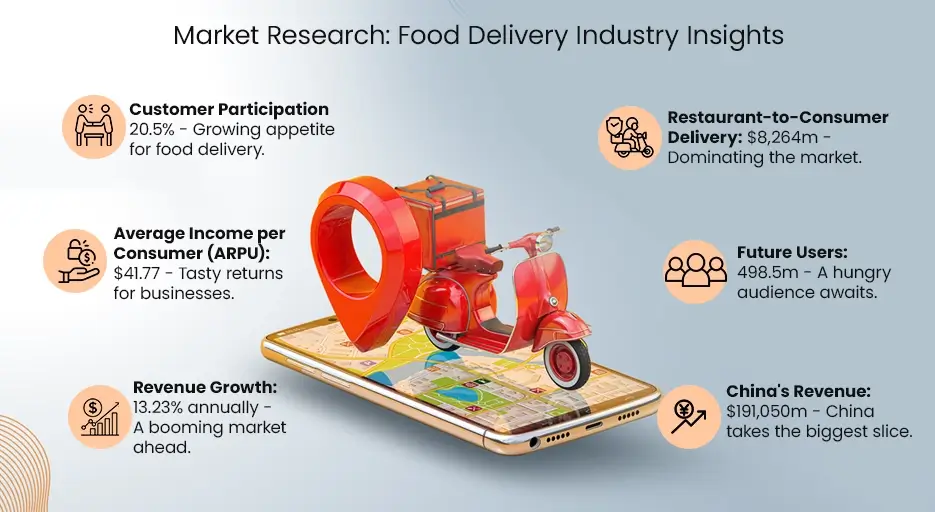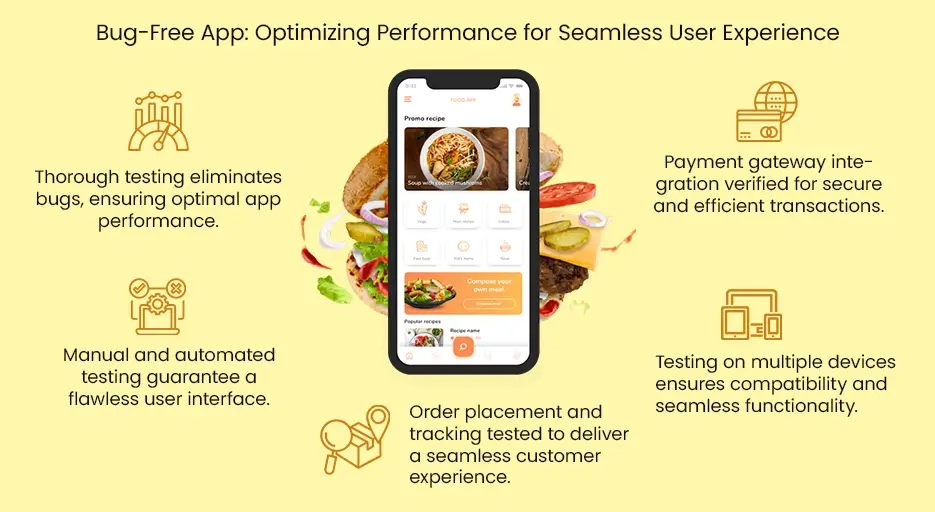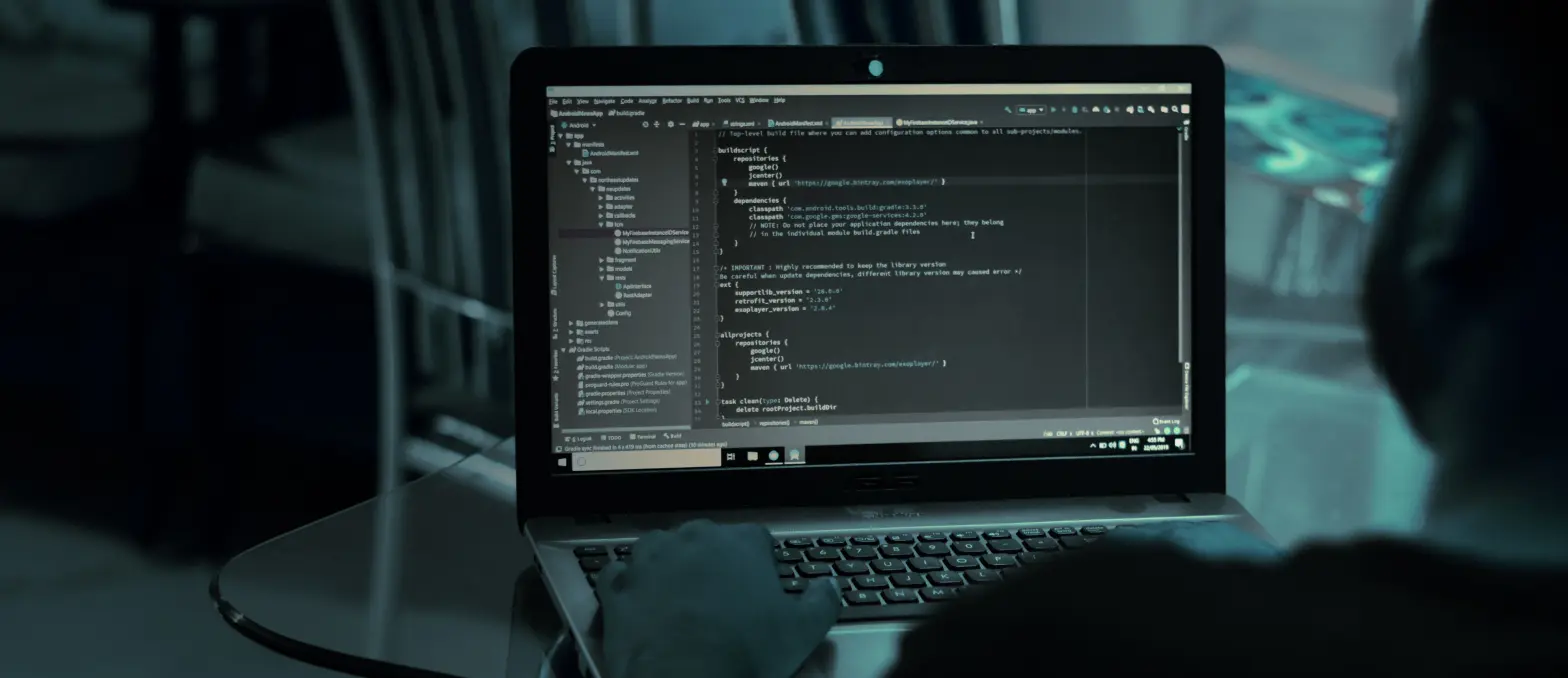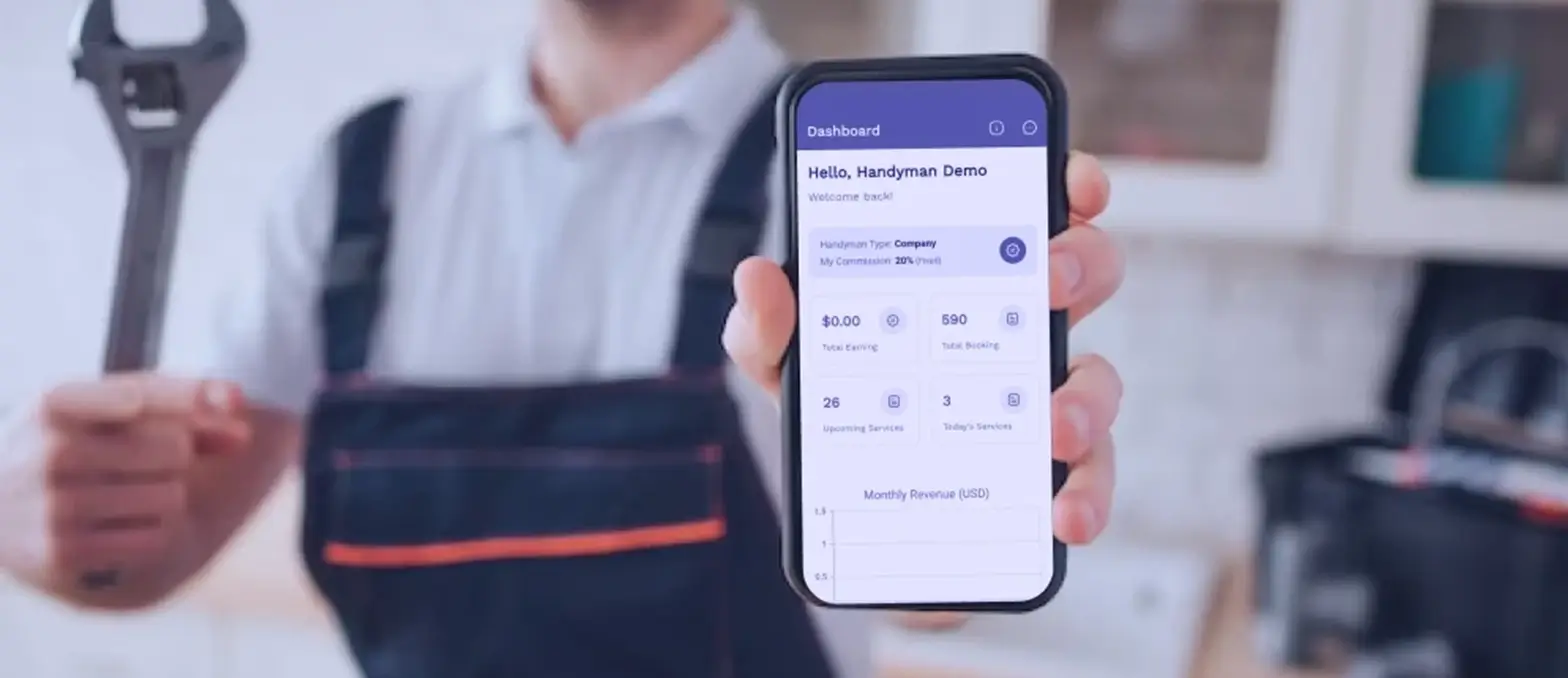The on-demand food delivery market has exploded in the past few years with the widespread adoption of smartphones. Developing a food delivery app is a significant investment for any business. This blog will give you a detailed guide on food delivery application development.
However, developing a successful food delivery app from scratch is no child’s play. It requires extensive planning around target customers, competitors, technical requirements, and operations. On demand food delivery app development companies will be helpful in a scenario where you have a lack of knowledge with respect to app development. This article aims to provide a comprehensive guide for anyone looking to enter this booming sector.
It will discuss essential aspects like identifying the target segment, analyzing rivals, understanding user needs, and addressing some frequently asked questions.
Overall, this blog will be an essential guide for anyone looking to develop their food delivery app, providing you with all the information you need to know to make your app successful through mobile application consulting services.
Food Delivery Application: Market Research
As per mobile app development companies in the USA, it will help you develop a successful app that meets the market’s demands.

- In 2025, the revenues of the food delivery segment will likely show an annual increase of 13.23 percent. This could result in a market size of $19,591m.
- In 2021, the market’s largest segment was Restaurant-to-Consumer Delivery, reaching market revenue of $8,264m.
- In 2025, the total number of people using the mobile app development services USA for food delivery segment is estimated to be approximately 498.5m.
Identifying Target Audience
The initial step in custom food delivery application development is to identify your targeted audiences. The initial step is deciding your target customer base. Will your app focus on a niche segment or aim for the mass market? Some factors to consider include:
Demographics: Narrow it down based on parameters like age, income level, family structure, location, etc. For example, targeting young professionals or families.
Location: All-city, neighborhood-based, or a few selected regions only. Choose based on delivery radius feasibility.
Cuisine Preference: Focus on specific cuisines like Asian, Italian or be an all-cuisine aggregator.
Timing: Cater to particular meal occasions like breakfast, lunch, dinner or late-night cravings.
Habits: Target health-conscious people wanting diet meals or busy professionals looking for quick fixes.
Clearly defining your target will help design the right UX, payment methods, restaurant partners and marketing approach. Start market research to understand user pain points and preferences for the shortlisted segment. Competitive insights will also guide refining your positioning.
Analyzing Competitors
Closely studying competitors is vital for several strategic decisions. Start by listing major players in your target city and their USPs. Compare aspects like:
Platforms: Apps only or apps with websites too? Native or hybrid development?
Business Model: Delivery only, dine-out too or hyperlocal grocery delivery as well?
Cuisines and Restaurant Partners: Specialized cuisines or all-cuisine listings?
Revenue Model: Commission, subscriptions, advertising or cloud kitchens?
Operations: In-house delivery fleets or third-party aggregators?
Prices: Delivery and service charge policies, minimum order amounts etc.
Technological Edge: Features, UX, database, mapping and inventory systems used.
Benchmarking will help determine your value proposition, platform edge, pricing and operational optimization compared to competitors. Their successes and failures also provide valuable insights to avoid pitfalls and stand out.
Identifying the Needs and Requirements of Users
According to the top mobile app development company USA experts, users expect standard features in a food delivery app. Understanding user pain points and wants is crucial for building a tailored solution. Conduct primary research through surveys and interviews with potential customers representing your target segment.
The key areas to focus on include:
Browsing Experience: Interface, filters, search, recommendations, favorites etc.
Ordering Workflows: Quick/express checkouts, multiple address save, order tracking etc.
Payment Options: Popular e-wallets, cards,Cash on Delivery (CoD), BNPL etc.
Delivery Particulars: Time estimates, real-time tracking, delivery slots, refund policies etc.
Restaurant Listings: Cuisine-wise categories, ratings & reviews, menu previews etc.
Promotions: Deals & offers, loyalty programs, referral schemes etc.
Post-purchase Support: Order cancellations, refunds, replacements, feedback mechanism etc.
Gather both quantitative and qualitative feedback to design seamless yet personalized experiences. Prototype the app based on learnings and test with target users to further refine requirements.
Are you Looking to Revolutionize the Food Delivery Industry with Your Own App?
Features of a Food Delivery Application
Here are some of the the essential features that any on demand food delivery app development company should consider:
User Registration and Login
An account registration and login system is among the most important features you can include in your app for food delivery. Users can register an account and save their details to be able to place future orders. It will help make it easier for customers to save time and energy when placing orders as they’ll only have to complete their information whenever they purchase food items.
Menu and Restaurant Browsing
According to a food delivery app development firm, a further important feature that should be included is the capability for customers to browse menus and restaurant options. This feature lets customers discover what options for food are available in their local area and then select the menu and restaurant they wish to purchase.
When creating the menus and the restaurant browsing option Make sure you arrange the menus and options for restaurants in a manner that is easy for users. It is possible to do this by categorizing the menus based on the type of restaurant or cuisine and also by incorporating high-quality photos of the menu items.
Order Placement and Tracking
The order tracking and placement feature is the primary element of any food delivery service. It allows customers to make orders quickly and monitor the progress of their orders in real time to be aware of when their food will arrive.
According to the agency for mobile app development Users should be able place orders swiftly and conveniently and monitor the status of their orders in real time. This can be accomplished by regularly updating the status of an order including when it was collected or is on its way, or when it was delivered.
Payment Gateway Integration
The integration of payment gateways is a crucial feature of any food delivery application. A safe and secure payment gateway allows customers to pay for their meals online. When developing this feature, ensure to provide a variety of payment options, including debit or credit card PayPal and other wallets that are digital. Additionally, make sure your payment processor is safe and reliable in order to safeguard the financial details of users.
Review and Rating System
The reviews and ratings system are a vital feature of your app for food delivery. It allows customers to write reviews and leave ratings on the food items and restaurants they’ve ordered, which helps others make better choices when making their purchases. When developing this feature, ensure it’s simple to use and easy for users. As per Best app development firms in the USA Users must be able to post reviews and ratings swiftly and easily. Additionally, the ratings should be prominently displayed to assist other users in making more informed choices.
Technology Stack
The development of a food delivery application requires a solid technology stack that is able to handle the complexity of the app’s features and functions. The technology stack for an app for mobile typically comprises frameworks and programming languages cloud hosting and infrastructure databases management systems, APIs and integrations.
Programming Languages and Frameworks
The choice of programming language and frameworks could significantly impact the speed and capacity of the food delivery application. Java is a fantastic choice to use for Android app development and Swift as well as Kotlin are great for iOS application development services.
Cloud Infrastructure and Hosting
Selecting the appropriate cloud infrastructure and hosting service is essential to the development of your app for food delivery. Hosting and cloud infrastructure allows your application to scale up or down based on demands of users and traffic. There are several cloud hosting providers available and include AWS, Azure, and Google Cloud Platform Services. Google Cloud is an excellent choice for developing apps as it has a variety of features, such as Compute Engine, Cloud Storage as well as Cloud SQL.
APIs and Integrations
Integrations and APIs are crucial for constructing an app for food delivery to connect with other platforms and services. APIs enable the app to connect to third-party services and retrieve information like reviews, menus, and ratings. Integrations let the app connect to other platforms, like payment gateways and social media.
In particular, integration with social media sites like Facebook and Twitter lets users post their food preferences with their family and friends. As per iOS app development agency Integrating with payment gateways like PayPal and Stripe allows users to pay securely within the application. APIs like Google Maps can be integrated into the app to offer precise services based on location for users.
Designing the User Interface
A user-friendly interface (UI) is crucial in making sure the app’s success is assured. application for food delivery. The UI must be easy to use as well as intuitive and appealing, allowing users to use the app quickly. There are a few important things to consider when making your UI to your restaurant delivery application.
User-friendly Interface
According to the Android app development firms user-friendly interfaces are crucial for the success of any app. It needs a simple layout, intuitive navigation and clear call-to-action buttons and easy checkout procedures.
Customization Options for Users
Options for customizing can improve user experience and help make the app more personalised for each user. It comes with features like the option to save your most-loved restaurants and dishes and a customized dashboard that lists customers’ previous orders and the option to personalize the order.
Push Notifications and Alerts
Alerts and push notifications are crucial to notify customers about their order’s status along with delivery dates as well as other important updates. For instance, they will receive an email notification when their order has been received and when it’s being made and sent out to be delivered. Also, they should get an email when their package has been delivered.
Building the Backend
After you’ve designed an interface for users and identified the features the app for food delivery will include then the second step would be to design the backend. The backend is a part of your app which the users can not get to see, but is where the app’s functionality is. In this article we will go over the essential aspects of creating the front end of a food delivery application.
Developing the Server-side Logic
The initial step in creating the food delivery backend application is to create servers-side software. This is the process of creating the algorithms that control the app’s logic for example, how customers will navigate menus, what restaurants accept orders, and the method by which dispatchers will be distributed. It is vital to understand the scope of the app’s needs to be sure the logic on servers has been designed to meet these needs.
Database Integration and Management
It is the next stage to connect databases with the application. The database will contain data about the app’s users restaurant menus, locations and even orders. It is vital to plan the database schema in a way that you make sure that the app can handle large amounts of data and be easy to manage. In addition, well-designed software for managing databases is vital to ensure that the app will function well and remain safe.
Implementing APIs
The last step to build an application that functions as a backend for delivering food applications will be the need to create APIs (Application Programming Interfaces). APIs are rules that facilitate interaction between software applications. For example, in the instance of an app for food delivery APIs are utilized for connecting the interface of users to the server-side logic as well as databases. They allow the application to get data from the server, and transmit it back on to the server. The implementation of APIs requires meticulous planning to ensure all data in the application is secured and that it performs efficiently.
In the end, creating the back-end for a delivery food application requires knowledge of the app’s needs and the technology required. It’s a complicated process that requires server-side logic, database management, and API implementation proficiency. If you’re lacking in this area, think about hiring an experienced mobile app developer service supplier or mobile apps development service company to ensure that your app is developed to the most stringent standards.
Testing and Launching
According to the on demand app development company Once you’ve completed the design of your food delivery app then the next stage is to test it and then release the application. This is an important step that requires attention to the smallest details and a commitment to rectifying any problems. In this article we will go over the steps involved in testing and opening the app for food delivery.
Conducting Thorough Testing to Identify and Fix Bugs
When your app is created the app must be tested thoroughly to find any issues or bugs. It is crucial to solve any issues or issues prior to the launch of your app. The users expect the highest level of performance and functionality from your app. Any issues could result in negative reviews and a loss of customers. You can hire a mobile app development company to help you conduct thorough testing and fix any issues.

Marketing Your Food Delivery Application
The next important step is to market your app to potential customers once the app has been developed and evaluated. Promoting your app can allow you to get more people to download it and increase downloads, which will result in increased profits and expansion for your company. Here are some successful ways to market your app for food delivery:
Promoting the App Through Digital Marketing
A great way to advertise your app for food delivery is via the use of digital or data-driven marketing. You can make use of various online channels like search engines and social media, as well as email, and display ads to advertise your app. For example, you can utilize pay-per-click advertisements to target people who are looking for delivery services on the internet.
Building a Referral Program
Referral marketing can be the best, fast and most effective method of marketing your app for food delivery. Referral programs help existing users to invite their friends and family to download your application. They can increase downloads and build a loyal customer base. It is possible to encourage customers to recommend to others by offering incentives like discounts, free deliveries as well as loyalty points.
Enhancing Brand Awareness through Social Media
Social media is a vital instrument for marketing your food delivery application. Social media is a great way to utilize platforms to establish a strong online presence and interact with potential clients. Sharing engaging content, like food photos or promotions will draw users to your application. Additionally, you can utilize social media to communicate with customers and collect feedback, which will aid in improving your app.
Final Thoughts
Building a competitive food delivery app requires extensive upfront planning across target markets, competitors, user research and technical specifications. Following proven strategies around positioning, operations, pricing and experience customization will help deliver true value. Regularly tracking industry and user trends post-launch also ensures sustainable growth. Entrepreneurs who are willing to put in the hard work at the conceptualization phase stand to gain in this highly promising on-demand delivery sector.
So, hire a custom app development service now from A3Logics and acknowledge the difference!
FAQs
How do I create a delivery app?
There are two main approaches – custom development or using no-code platforms. For custom, identify features and hire a mobile app development company to build it natively for iOS and Android. For no-code, use tools like AppMaster, AppyPie etc which provide blueprints to drag-and-drop build the MVP and later customize features. Either way, core aspects like order management, payments, delivery, backend integration are essential. Connect with the A3Logics, leading mobile app development company in the business to know more.
What is the cost of developing a food delivery app?
The cost of developing a food delivery app can vary. The overall budget depends on various factors like features, target platforms, developer expertise, development approach etc. However, generally – a basic MVP can cost $25,000-$50,000 while a complex full-featured app may be $150,000-$250,000 for custom development. No-code options fall under $10,000 for simpler solutions. Ongoing costs include server, subscription charges, maintenance and additional features.
Which API is used in food delivery apps?
Major APIs used are – mapping APIs like Google Maps and Mapbox for directions, plotting delivery agents and stores; payment gateways like Paytm, Razorpay, Stripe for processing transactions; third party delivery fleets like Shadowfax, UberEats, Zomato partner APIs for order assignment and tracking; and customer management APIs for CRM, notifications, authentication etc.
Are food delivery apps profitable?
According to Statista, revenue from online food delivery market is expected to show an annual growth rate (CAGR 2023-2027) of 12.78%, resulting in a projected market volume of US$2tn by 2027. The potential for profitability is high considering the growing demand and market size. However, it requires strategic focus across customer acquisition and retention, operational optimization, pricing and scaling up. Gradually building market share, keeping overhead costs low through automated processes and cloud infrastructure helps achieve profitability sooner especially in high density cities. Competition and regulatory challenges remain, but established brands with network advantages report improving margins over time.
Why should you develop your food delivery app?
Other than tapping into the booming sector, there are key advantages – full control over user experience and innovations as per target segment needs without relying on third party limitations. Possibility of multiple revenue streams through multiple business models under one platform versus commissions alone. Owning customer data for insights and independent marketing vs data sharing with aggregators. Increased brand visibility and establishing a direct relationship with end users and restaurant partners. Future scope to expand into adjacent services leveraging the existing fleet network and customer base.













